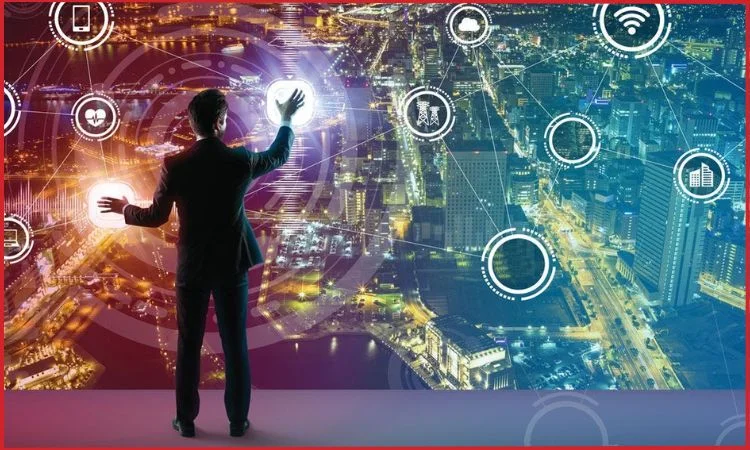In an era of rapid digital transformation, staying ahead of the curve is crucial for both professionals and businesses. As we approach 2025, the technological landscape continues to evolve at an unprecedented pace, reshaping industries and redefining the future of work.
This comprehensive guide explores the top 10 game-changing technologies that are set to make a significant impact in the coming year and beyond.

Here is The list Of 10 Game-Changing technologies to watch in 2025
| S. No. | 10 Game-Changing technologies to watch in 2025 |
| 1. | Artificial Intelligence (AI) and Machine Learning (ML) |
| 2. | 5G and Beyond |
| 3. | Quantum Computing |
| 4. | Augmented Reality (AR) and Virtual Reality (VR) |
| 5. | Voice-Activated Technology |
| 6. | Internet of Things (IoT) |
| 7. | Autonomous Vehicles |
| 8. | Biotechnology |
| 9. | Edge Computing |
| 10. | Cybersecurity Advances |
1. Artificial Intelligence (AI) and Machine Learning (ML)
Artificial intelligence has been a trend for many years, and in 2025, it will play an even more significant role than before. On the other hand, AI is about imitating human intelligence through the use of machines and computer programs to perform tasks that would normally require human thinking.
Artificial intelligence can be divided into two main categories: Machine learning aims at providing mechanics for creating programs that can learn from data and make intelligent decisions.
Key Developments:
AI in Business Intelligence: Research also shows that more than 75 percent of the venture capital investors are likely to apply AI technology for information gathering by the year 2025, and this will change the way people make decisions.
Personalization: AI will be instrumental, when it comes to identifying the customer activities and improving marketing initiatives across sectors and sub-sectors.
Job Creation: From the graph, it can be noted that AI is expected to create 2. 2 4 million jobs, which have created extended prospects to build in data science, artificial intelligence engineering, and machine learning.
Industry Growth: It is estimated that by 2025 AI & Machine Learning will be constituting 9% of the total new tech hires in the US, which is a great potential for a professional in this discipline.
Impact on Industries:
Healthcare: diagnostic software and applications based on artificial intelligence, this and different treatment regimens.
Finance: Some of the applications are fraud detection, algorithmic trading, and risk assessment.
Retail: Artificial intelligence for demand forecasting and supply chain inventory, customer engagement on a high level
2. 5G and Beyond
The fifth generation networks, or 5G, promised to dictate the trend for the future and open the door for a range of more advanced technologies and services. Being faster, less-latency, and more capable than 4G, 5G is not just iteration above the previous generation but a revolution.
Key Features:
Speed: Up to 100 times faster than 4G, allowing for fast download, real time data analysis, and utilization.
Low Latency: Low latencies that are vital in applications that include self-driving vehicles as well as robotic operations such as surgery.
Increased Capacity: Capacity for wiring more devices at one time, in line with the increasing prevalence of the Internet of Things.
Enabling Technologies
Internet of Things (IoT): 5G will offer the required platform for a number of smart gadgets to effectively interconnect.
Smart Cities: 5G technology will enable the implementation of smart sensors and technological solutions for infrastructural management to a much greater extent.
With the continued provision of 5G networks across the world, many new features as well as services that shall utilize this technology are likely to emerge. Experts in telecommunication and internet, network engineering, and IoT designs will benefit a lot in the future from this flourishing discipline.
3. Quantum Computing
Quantum computing is a new generation computational system on which many problems can be solved that cannot be solved by the conventional system or classical computer. It is unlike traditional computers, which employ Bi s or 0 and 1, and instead employ quantum bits abbreviated as qubits, which are able to possess more than one state at the same time.
Key Applications:
Drug Discovery: Mimicking task to prompt the process of designing drugs and therapeutic products.
Financial modeling: also involves enhancing investment decision possibilities and risk management.
Cryptography: innovating the methods of encrypting and decrypting data and sometimes creating ways of cracking the already-set codes.
Climate modeling: developing improved climates to have better forecasts and prevent any changes in the environment.
Challenges and Opportunities:
However, the concept of quantum computing is not new, and the big players in the technology industry, along with new emerging companies, are currently putting their bets. When quantum computers are realized and become realistic in the near future, there will be increased demand for quantum physicists, quantum software developers, and quantum algorithm designers, among others.
4. Augmented Reality Systems (ARS) and Virtual Reality Systems (VRS)
Augmented reality (AR) and virtual reality (VR) technologies are heading towards the future of human beings’s interaction with digital content and the real world. In a way, VR engulfs the user into new artificial worlds while AR places digital supplements on to the existing environment.
Market Growth:
It is estimated that the size of the AR market will be $198 billion larger by the end of 2025.
Presently, there are more than 171 million users of virtual reality technology.
Key Applications:
Education: simulation and game-based learning and virtual and interactive educational travels.
Healthcare: surgery, as well as the training of surgeons and therapists, and the patients’ recovery.
Retail: Appointments for virtual fittings and simulated functions of the products
Real Estate: Digital estate preview and architectural representation
Entertainment: Gaming and emphatic strorytelling
The Metaverse:
The collective shared space – the Metaverse concept is becoming the primary source of investment in 3D technologies like AR and VR. With that, one can only await new platforms and applications that will form out of these technologies as more advanced technologies merge the physical with the digital.
There are also recommendations for people practicing in this industry, the most suitable ones are considered to be those with 3D modeling, game development, or UX design experience. More and more people will look for developers and designers specialized in AR and VR technology, because they constantly develop as a trend.
5. Voice-Activated Technology
Siri, Alexa, and Cortana are today’s reality and show that smart voice-activated technology has now entered the society in recent past. From the smart speakers to virtual companions’ assistant, voice activated systems are redefining the ways of human-interaction and access to information.
Key Statistics:
By 2021, market penetration reached an all-time high of 50% smart speaker ownership in US households.
Further, voice search is forecasted to take half of all the searches in the continued year of 2025.
Applications:
Smart Home Devices: Everything connected to the management of lights, thermostats, and all the other home electronics appliances.
Virtual Assistants: Siri, Alexa, and Google Assistant for activities’ scheduling and for looking for some specific information.
Automotive: Some of the technologies include voice command controls of the navigation and entertainment systems.
Accessibility: To provide an easier means of using technology by the disabled.
Future Developments:
In this regard, we may also note the potential of voice-activated technology that results from enhanced NLP and AI algorithms; one may expect it would become increasingly context-sensitive. This will create a window of opportunities for voice based UI in almost every industry possible.
6. Internet of Things (IoT)
The Internet of Things (IoT) is the phenomenon where multiple gadgets are connected with each other and are able to transfer data. Today it is impossible to come across a home or an industry that has not embraced IoT with smart home devices to industrial sensors.
Growth Projections:
For the device of IoT, it is predicted that more than 21 billion devices will be there by 2025.
Key Applications:
Smart Cities: In other parts, the context embodies efficient use of resources, traffic, as well as the provision of services to the public.
Industrial IoT : predictive reliability and improvement of production lines
Healthcare: telemonitoring and connected health or smart health products
Agriculture: Precision agriculture and last management of animals
Retail: Storing inventory and fulfillment of customer preferences
Challenges and Opportunities
Looking at IoT, some of the future problems will include the following, data security, data privacy, and the problem of compatibility. It therefore opens prospects for IT professionals with a specific focus on Internet of Things security, big data, and system integration.
7. Autonomous Vehicles
Self-driving cars are a combination of AI, sensors, and sophisticated control systems. Essentially, there are still full autonomous cars under development, but there has been a remarkable advancement in semi-autonomy.
Key Features:
AI-powered decision making: Opportunity to control and act correspondingly to the existing traffic.
Sensor fusion: Synchronization of information from various sensors for perception perfection
V2X communication: Could you tell me some ideas that are associated with
Potential Impact:
Safe road use with minimized cases of accidents and their related deaths
This actually meant minimizing bottlenecks and general enhancement of the existing traffic situation.
More mobility for the elderly and the physically challenged people.
Revolution of the urban planning and of parking structures.
With the progress in the use of AV technology, there will be an increased need for experts in areas such as AI, robotics, and transportation systems engineering.
8. Biotechnology
Biotechnology is the use of living organisms in the provision of goods and services, a field that has huge opportunities of bringing about changes in 2025 and the next generation.
Key Areas of Innovation:
Gene Editing: The application of CRISPR and other gene editing tools in medicine and agriculture are among the few that have brought significant change.
Synthetic Biology: The design and synthesis of biomimetic systems for health care products, industry, and the environment.
Personalized Medicine: This means that medical practitioners are able to administer different treatments to patients depending on his/her genetic make up.
Biofuels: Creation of improved strategies of resource and energy management: transition to the use of renewable sources of fuel
9. Edge Computing
This has become a big problem, especially where the number of devices connected to the internet is very large, and this has been solved by edge computing.
Key Features:
Proximity: Analysis and transformation of data done near the place where it is collected.
Reduced Latency: Quicker response time for critical use as in the case of real-time applications.
Bandwidth Optimization: Minimizing data transmissions to centralized data processors.
Applications:
Autonomous Vehicles: Real-time analysis of the data collected from the various sensors.
Industrial IoT: Auditing and supervision of the manufacturing activity
Smart Cities: Congestion control and safety measures for the people
Content Delivery: Better streaming on media and gaming platforms
Career Opportunities:
But with each passing day, the concept of edge computing is emerging among professionals with expertise in cloud computing, IoT, and distributed system specialties like edge computing architects, IoT solutions engineers, and distributed systems developers.
10. Cybersecurity Advances
As we continue to experience technological processing and archiving, the issue of security is kept raised. In the year 2025, it will be possible to record high levels of growth in cybersecurity solutions technology, especially in the automation of the technology where AI and machine learning are adopted.
Key Developments:
AI-powered Threat Detection: Applying ML models for detection and prevention of threats and risks in a real-time manner.
Behavioral Analytics: Implementing or applying statistical or other models of users’ behaviors in order to identify oddities and possible security threats.
Zero Trust Architecture: Creating security models that need verification from individuals who want to access assets in a network.
Quantum-resistant Cryptography: Coming up with algorithms that are hard for quantum computers to break down ranks highly as one of the biggest challenges that need to be addressed.
Impact on Industries:
Finance: Better protection from fraud cases and safe execution of transactions
Healthcare: Patient’s privacy and keeping up with the set regulatory and legal necessities
Government: Protection of important buildings, facilities, our information, and general security of the country.
Retail: Ensuring safety of the e-commerce sites and customers’ information
Since the threats keep on enhancing in the virtual world, the need for the experts in cybersecurity will always be felt. The cybersecurity analyst, ethical hacker, security architect, etc. , are some of the positions that will be very important in security organizations and individuals against cyber threats.
Conclusion
As we look ahead to 2025 and beyond, it’s clear that the pace of technological innovation shows no signs of slowing down. From AI and quantum computing to biotechnology and autonomous vehicles, these game-changing technologies are set to reshape industries, create new job opportunities, and transform how we live and work.
For professionals and businesses alike, staying informed about these technological trends is crucial for remaining competitive in an increasingly digital world. Whether you’re a seasoned tech expert or just starting your career, there’s never been a more exciting time to be involved in the world of technology.
As we embrace these innovations, it’s important to consider not just their technical aspects, but also their ethical implications and societal impacts. By doing so, we can ensure that these game-changing technologies are developed and deployed in ways that benefit humanity as a whole.















